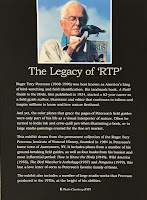A Giant in the World of Nature
Roger Tory Peterson was many things; a naturalist, an artist, an ornithologist, an environmentalist and an educator. If you’ve ever browsed a nature store, chances are you’ve seen a Peterson Guide. He brought birding and nature to national prominence through his guides and illustrations.
 Les Line, a former editor of Audubon, wrote: “Because of Peterson, we became watchers not just of birds, his greatest love. Through the magic of The Peterson Field Guide series, which grew to more than 30 volumes under his editorship, we became watchers--and, more importantly, protectors--of every form of life on our planet.”
Les Line, a former editor of Audubon, wrote: “Because of Peterson, we became watchers not just of birds, his greatest love. Through the magic of The Peterson Field Guide series, which grew to more than 30 volumes under his editorship, we became watchers--and, more importantly, protectors--of every form of life on our planet.”
In the 1930s when he submitted his first field guide, publishers turned him down. Houghton-Mifflin finally agreed to publish his book, anticipating little success. However, the first printing of 2,000 copies sold out within a week. His fame soared and over the next fifty years, Peterson wrote nearly as many books.
 Peterson changed birding from a narrower “sportsman’s interest" to a much broader pastime. By creating a visual identification system that used shapes and field marks, he turned amateurs into birding enthusiasts. According to the US Fish and Wildlife Service in 2006, forty-eight million Americans watch birds. In 2016, they reported that 101.6 million Americans, or 40 percent of the adult population, participated in wildlife-related activities, such as hunting, fishing and wildlife watching.
Peterson changed birding from a narrower “sportsman’s interest" to a much broader pastime. By creating a visual identification system that used shapes and field marks, he turned amateurs into birding enthusiasts. According to the US Fish and Wildlife Service in 2006, forty-eight million Americans watch birds. In 2016, they reported that 101.6 million Americans, or 40 percent of the adult population, participated in wildlife-related activities, such as hunting, fishing and wildlife watching.
Unlike hunting and fishing that are widely skewed toward men, birdwatching is fairly evenly divided between men and women.
LiveScience.com reports that avitourism (birdwatching tourism) is “one of the most lucrative sources of income in ecotourism”. According to a US Fish and Wildlife report in 2006, this amounted to about $36 billion in the US economy.
 Many people credit much of this growth to the prolific life work of Roger Tory Peterson. The institute in Jamestown showcases the diversity of his award-winning work. His art graced a number of magazine covers, particularly Life Magazine, as well as his own books. His work ranged from India ink illustrations and oil paintings to sketches and photography. His subject matter was also diverse, covering almost anything in the natural world. His field guides include subjects such as butterflies, shells, rocks, beetles and flowers.
Many people credit much of this growth to the prolific life work of Roger Tory Peterson. The institute in Jamestown showcases the diversity of his award-winning work. His art graced a number of magazine covers, particularly Life Magazine, as well as his own books. His work ranged from India ink illustrations and oil paintings to sketches and photography. His subject matter was also diverse, covering almost anything in the natural world. His field guides include subjects such as butterflies, shells, rocks, beetles and flowers.
Peterson received many awards throughout his career including the Presidential Medal of Freedom.
A trip to the Roger Tory Peterson Institute at 311 Curtis in Jamestown, NY, offers the visitor a glimpse into the man and the tremendous impact he had on Americans’ love affair with the natural world and the need for environmental conservation.



Comments
Post a Comment